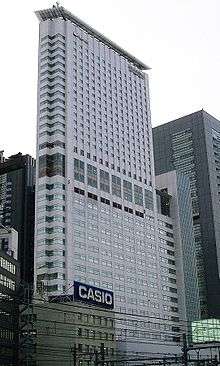Microsoft Japan
Microsoft Japan, officially Microsoft Japan Company, Limited (日本マイクロソフト株式会社, Nihon Maikurosofuto Kabushiki Kaisha), is a subsidiary of Microsoft based in Japan. Their headquarters are at Shinagawa[6] district of Tokyo.
Native name | 日本マイクロソフト |
|---|---|
| Founded | 1986 as Microsoft Kabushiki Kaisha |
| Founder | Bill Gates |
| Headquarters | Shinagawa, Tokyo , Japan |
Key people | Susumu Furukawa, President (1986 - 1992)[1]
Takuya Hirano,[2] President & CEO (2015 -) |
Number of employees | 1,793 (2006)[3] |
| Parent | Microsoft |
| Website | www.microsoft.com/ja-jp/ |
Native name | マイクロソフト ディベロップメント |
|---|---|
| Founded | November 16, 2005 |
| Founder | Bill Gates |
| Headquarters | Chōfu, Tokyo , Japan |
Key people | Shunichi Kajisa,[4] President and Representative Director |
Number of employees | 371 (2006)[5] |
| Website | www.microsoft.com/ja-jp/ |

History
In 1978, Kazuhiko Nishi, a founder of ASCII Publisher, became friends with Bill Gates. In 1979, he founded ASCII Microsoft (株式会社アスキー・マイクロソフト) as the sole dealer of Microsoft's products in Japan. In 1980, ASCII made 1.2 billion yen of sales from licensing Microsoft BASIC. It was 40 percent of Microsoft's sales, and Nishi became Microsoft's Vice President of Sales for Far East.[7] In 1983, ASCII and Microsoft announced MSX. In 1984, ASCII Microsoft was merged to ASCII.
However, Microsoft founded its own Japan subsidiary, Microsoft Kabushiki Kaisha (マイクロソフト株式会社, MSKK), and dissolved partnership with ASCII in 1986. It was because Gates wanted Microsoft to go public in the New York Stock Exchange, and also he opposed Nishi and ASCII's diversification. Susumu Furukawa (古川 享), who was also a member of ASCII, officially became the first president of Microsoft Kabushiki Kaisha. ASCII kept rights of MSX.[8]
In October 1986, MSKK announced the AX project that was a Japanese computing initiative to allow IBM PCs to handle Japanese text.[7] The AX couldn't break into the Japanese PC market due to its cost and less available software.
In October 1990, IBM Japan announced the DOS/V. Soon after the announcement, Furukawa got a contract with IBM Japan to receive source code of DOS/V.[9] MSKK supplied own DOS/V for PC manufacturer.
For the Japanese adaptation of Windows 3.1, MSKK and Ricoh developed two Japanese TrueType fonts, MS Gothic and MS Mincho. It took two years, and delayed the Japanese adoption of Windows 3.1.[10] However, it became the first successful version of Windows in Japan.[11]
In 1998, the Japan Fair Trade Commission informed Microsoft of an unfair trade that Microsoft forced personal computer manufacturers to bundle with Excel and Word against the request of a bundle with Excel and Ichitaro.[12] The company faced another JFTC scrutiny (in midst of European Union actions against Microsoft) when the company was accused of having clauses that hurt the ability of Japanese computer manufacturers to obtain an OEM Windows license in 2004.
Microsoft Japan conducted a trial 4-day work week in summer 2019, granting workers paid leave on Fridays. At the same time it cut the length of most meetings from a full hour to half an hour, and capped attendance at five employees. For the duration of the trial, the company reported a 40% increase in productivity and 23% reduction in electricity costs.[13]
Products
Microsoft Hagaki Studio
Microsoft Hagaki Studio (マイクロソフト はがきスタジオ, Microsoft Postcard Studio) is a discontinued postcard software for printing nengajo (New Year's Day postcard). The software was released only in Japan from 1997 to 2006. It provided the upgrade path from other competitors such as Fudemame (筆まめ) and Fudeoh (筆王),[14] but Microsoft Hagaki Studio 2007 was the last version of the software.[15]
Events
- May 13, 2005 - Yoshihiro Maruyama presented the Xbox 360 to the public.
Sponsorship
From 2004 to 2009 the company sponsored the Microsoft Cup, a knockout rugby football tournament contested by the best Japanese teams from the Top League.
References
- "マイクロソフト・古川享最高技術責任者が会見". 22 April 2004. Retrieved 15 September 2019.
- "Takuya Hirano - Microsoft Japan President and CEO". Retrieved 6 July 2018.
- "日本マイクロソフト株式会社 会社概要". Retrieved 3 July 2006.
- "Shunichi Kajisa: Microsoft Japan". Retrieved 17 July 2014.
- "マイクロソフト ディベロップメント株式会社 会社概要". Retrieved 3 July 2006.
- "マイクロソフト日本法人、来年2月に本社を品川に移転". Retrieved 4 April 2012.
- コンピュータ・ニュース社, ed. (1988). "「パソコン産業史」年表". 100万人の謎を解く ザ・PCの系譜 (in Japanese). コンピュータ・ニュース社. pp. 40–57. ISBN 4-8061-0316-0.
- "動きだした米国マイクロソフト社日本法人". ASCII. ASCII. 10 (6). 1986. ISSN 0287-9506.
- Furukawa, Susumu (2015). 僕が伝えたかったこと、古川享のパソコン秘史. Japan: Impress R&D. ISBN 978-4-8443-9700-7.
- "リコー、マイクロソフトと提携―パソコン向け漢字ソフトを供給。". Nikkei Sangyo Shimbun. 1993-05-17. p. 1.
- Information Processing Society of Japan (2010). 日本のコンピュータ史 (in Japanese). オーム社. pp. 106–107. ISBN 9784274209338.
- "公正取引委員会、マイクロソフトへの勧告内容をPDFファイルで公開". Impress PC watch. 1998-11-24. Retrieved 2019-03-31.
- 4-Day Workweek Boosted Workers' Productivity By 40%, Microsoft Japan Says
- "Microsoft はがきスタジオ 2003、製品ラインナップ". Microsoft Japan. Archived from the original on 2003-02-26. Retrieved 2019-09-20.
- 大河原, 克行 (2007-11-05). "大河原克行の「パソコン業界、東奔西走」". pc.watch.impress.co.jp. Retrieved 2019-09-20.
External links
- Official website (in Japanese)